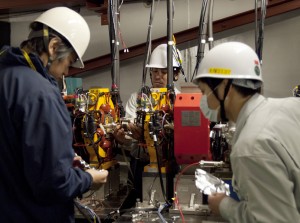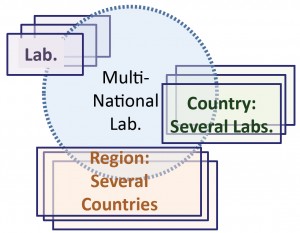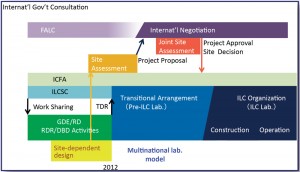
Scientists and engineers at KEK in Japan check the damage of the Accelerator Test Facility. Image: KEK
Almost four weeks have passed since the worst disaster that has ever hit northeast Japan. KEK has been evaluating damage to its facilities and buildings and is planning to release the official disaster report soon. Recovery activities that do not require much electricity consumption have begun already as KEK employees work to return operations to normal as quickly as possible.
“First of all, I would like to state that KEK won’t change any plans related to ILC activities”, said Atsuto Suzuki, director general of KEK. “The priority there now is to recover activities for the Accelerator Test Facility (ATF) and the Superconducting RF Test Facility (STF),” he said, stating his strong will to resume ILC R&D at KEK’s test facilities.
Scientists all over the world are now working hard to carry out the critical R&D programme needed to build the ILC.
The Global Design Effort is currently working to complete a Technical Design Report (TDR) for accelerator design by the end of 2012. The Research Directorate is also writing up the Detailed Baseline Design Report (DBD) on detector design. These documents may be used as the basis of funding proposals to collaborating governments.
Completion of the TDR and DBD in 2012 marks the conclusion of the present mandate for the Global Design Effort (GDE) and the Research Directorate (RD), and that has led to ongoing, extensive discussion on ILC governance after 2013.
Members of the ILC Steering Committee (ILCSC), the body that oversees GDE activities, have received a draft of the Comprehensive Project Design Guidance (CPDG). In this document, four possible governance models were discussed without making a choice among them. Members of the ILCSC siting work group – Joachim Mnich (DESY), Pier Oddone (FNAL) and Suzuki – drafted the CPDG.
One of the four governance models described in the CPDG is the Multinational Laboratory model: a laboratory formed by member countries, regions, laboratories and universities that contribute various resources such as human resources, accelerator elements and equipment and funds. The laboratory’s main campus will physically exist in some country and members will have branches on the campus. The members will maintain their own activities in each country as well as keep up activity at the ILC lab.
“I think the governance model called the Multinational Laboratory model will be the best fit for the future ILC laboratory,” said Suzuki. “The world community has agreed to establish a pre-ILC lab, the precursor body for the ILC organisation that will manage ILC activities after 2013. Also, there is a consensus that the pre-ILC lab should be started as a multinational laboratory.”
“The key words are partnership and decentralisation. We believe that the formation of a pre-ILC lab based on the Multinational Laboratory model can be relatively smooth with expansion of the present management bodies,” said Suzuki.
At that point, the ILCSC, together with GDE and RD, will be dissolved into the new laboratory to coordinate the remaining technical and engineering efforts in both the accelerator and the physics and detector areas.
“KEK is committed to working on the establishment of a pre-ILC lab, and there is no schedule change on these activities,” Suzuki said.



Recent Comments